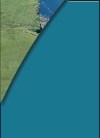County Clare was formerly part of the kingdom of Thomond
(north Munster) which comprised, in addition to
Clare,
portions of Limerick, Offaly and Tipperary. Clare formed,
however, the central or core territory of the old kingdom
and by the time the earldom of Thomond was created in the
16th century, its extent was limited, more or less, to the
present county.
The earliest inhabitants of Clare are part
of pre-history and there is, therefore, no certain knowledge
of who they were or where they came from. The Leabhar Gabhála,
or Book of Invasions, a compendium of largely mythological accounts
of successive occupations by overseas land-seekers, connects Clare
with the Fir Bolg.
This people, after various adventures, settled
in the west of Ireland and are identified with Magh Adhair in Clare,
Lough Cutra in Galway, and Dún Aongus in the Aran Islands.
In historical times the first figure to emerge from the mists was
a certain Cas, a contemporary of St. Patrick (5th century) and a
member of the Munster royal family. His descendants occupied
territory between Cashel and Limerick. Early in the 10th century
the Dal gCais (sept or tribe of Cas), or Dalcassians, began to
work their way across the Shannon into Clare.
An uncle of Brian
Boru, named Lachtna, established himself just north of Killaloe
at Crag Liath (the grey rock) about 950. He was succeeded first
by his nephew Mahon and then in 975 by a second nephew, the great
Brian Boru. Besides extending their overlordship in Clare, both
Mahon and Brian conducted an active and ultimately successful
campaign against the Norsemen of Limerick and Scattery Island.
The campaign became a nationwide struggle, culminating in the
great victory at Clontarf, near Dublin, in 1014.
Brian had become High-King of Ireland in 1002, built Kincora as
his royal residence in 1012, rebuilt the churches of Killaloe and
Inis Cealtra (Holy Island), erected bridges and made roads. He was
the greatest of pre- Norman kings. Brian Boru was killed at Clontarf
in his battle against the Danes of Dublin and following his death
the O'Brien hegemony of Munster was broken, while the semblance of
national unity he had managed to create soon disappeared. The O'Briens,
now limited to north Munster or Thomond, kept up hostilities with
varying success against the O'Conors of Connaught, until it occurred
to Donal Mor O'Brien, the incumbent chief, to call in aid a new group
of invaders. In 1172 he swore allegiance to Henry II of England and got
the help of a party of Norman mercenaries in pursuit of his war aims.
His successor also did homage
to King John at Waterford and was rewarded with the kingship of Thomond.
But the Normans balanced the account by expelling him from Limerick,
whereupon he retired to Clonroad near Ennis, which remained the O'Brien
headquarters for some centuries.
Despite some initial attempts the Normans failed to secure any permanent
footing in Clare. A son of the Earl of Gloucester, Thomas de Clare,
(the family name of Strongbow, incidentally, neither derived from nor
bestowed on the county) managed to occupy part of southern Clare, where
he built the castle of Bunratty in 1277. But the de Clares were expelled
following the battle of Desert O'Dea in 1318 and the English did not
reappear in the county for more than two centuries.
The accession of Henry
Vlll in 1534 and his acknowledgement as King ot Ireland marked the revival
of English power in those parts of Ireland outside the, Pale the area
round Dublin where the King's writ ran. The re-assertion of royal dominance
was felt in Clare, where Morrogh O'Brien became Earl of Thomond in 1541,
when it was detached from Munster and placed under the Presidency of
Connaught.
It did not rejoin Munster until the Restoration in 1660. The O'Briens
remained
loyal to the Crown, more or less, during the confused period up to the
Cromwellian conquest. The Earl of Thomond and the Baron of Inchiquin took
arms against the Great O'Neill and Red Hugh O'Donnell in the Elizabethan
wars. In the 1641 uprising, the Earl of Thomond did his best at first to
protect english interests, but many prominent O'Briens, MacNamaras and
others of that extended family sided with the Catholic cause and took part
in the Confederation of Kilkenny.
When the civil war broke out in England,
Barnabas, Earl of Thomond, leaned towards Charles I, but in 1646 reluctantly
admitted a parliamentary garrison to the great castle of Bunratty.
The castle was shortly afterwards recovered by the confederate army, but was
finally taken by Ireton in the Cromwellian overthrow. The rest of Clare followed.
The Cromwellian wars left Clare in ruins, racked by famine and depopulated.
The county, as part of Connaught, became a refuge for the dispossessed Irish
from the rest of the island. The Earl of Thomond went to England where he died
in 1657. Morrogh, Baron Inchiquin, an able general,
put up some resistance to the parliament forces but eventually fled to France
where he remained until the Restoration. He was rewarded by Charles II
with the presidency of Munster.
 Next
Next
|

